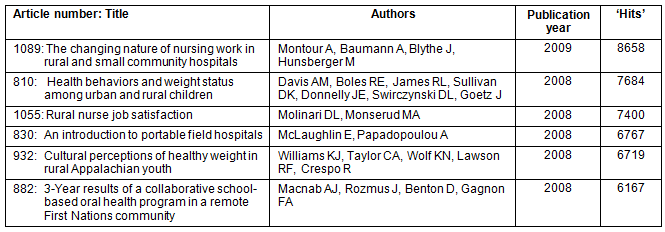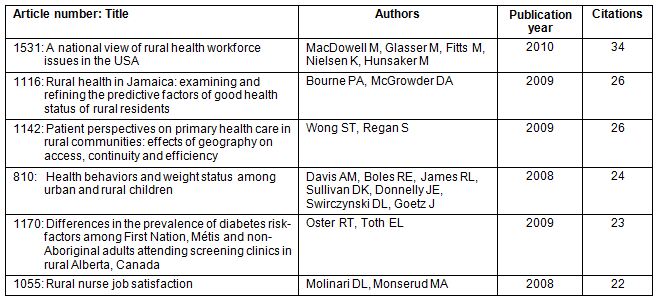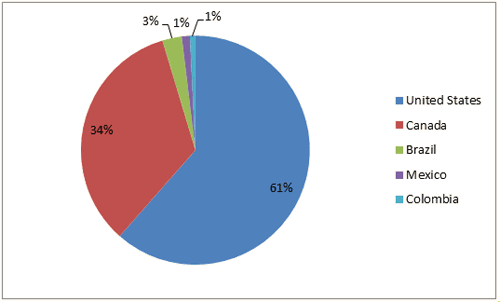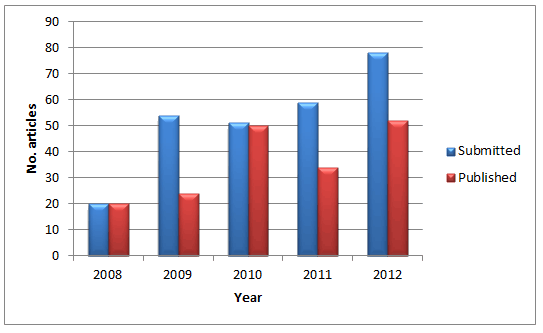The North American section turns five this month. It started with a dream to ensure that all rural areas of the globe would be included in Rural and Remote Health. The dream was further fueled by the desire that a formalized North American section would offer the opportunity to learn about projects and outcomes being initiated and implemented by established and emerging scholars, as well as clinicians, program managers and decision-makers - all with a passion for rural health.
In the beginning
Our dream has been realized by the collective efforts of many - the two Co-Editors, Regional Editorial Panel members, Journal staff, authors, reviewers and readers. To each of you we owe heartfelt thanks for supporting the North American Regional Section, helping to shape it and making it the success it is today. We have benefitted greatly from the collective wisdom of our editorial panel. We also thank the inaugural North American Editorial Panel members: some have moved on to other activities while others are completing their terms. The first 5 years benefited greatly from the interest, dedication and efforts of this group. We now have a number of new Panel members representing the different categories within rural health. The biographies and pictures of current Panel members have been provided in a news item so you can get to know them.
Early success and consolidation
Our inaugural Editorial emphasized that the 'time has come' for such an initiative1. Our 5th anniversary editorial emphasizes that 'timing is everything'. The graphs and tables that accompany this Editorial show that the North American section is well used and accessed by readers.
One article from 2009 (focusing on health human resources)2 and five articles from 2008 (focusing on health issues and on health human resources)3-7 are the articles with the highest number of accesses or 'hits' since the North American section was formalized (Table 1). However, we would be remiss if we did not mention a 2006 article that has the honor of the highest number of hits for the whole journal in any year (ie 39 511)8. Understandably, most of the hits are from United States and Canada (95%) but individuals from other countries on the continent also access articles in increasing numbers (Fig 1). The focus of the six articles with the highest citations in the 5 year period range from rural health human resources to health issues experienced by rural residents (Table 2).
Table 1: Six most frequently accessed North American Rural and Remote Health articles since May 2008

Table 2: Six most highly cited North American Rural and Remote Health articles since May 2008


Figure 1: Country origin on American continent of site visitors, 2012-2013.
Soon after we formalized the section, it was confirmed by the number of submissions and the geographic locations of origin that there were many potential authors across North America who welcomed this section and this Journal as an venue for publishing their work. An accompanying figure illustrates this well (Fig 2). In 2008, we had 20 articles submitted and published, and by 2012 this had risen to almost 80 submissions and just over 50 published. In 2011, we launched the Circumpolar Special issue: Human Health at the Ends of the Earth. Our focus on this special issue meant there was a lower number of articles published overall; however, the special issue opened the door to potential authors and reviewers who were new to our Journal.

Figure 2: Manuscripts submitted to and published in the North American Regional Section, 2008-2012.
It has been gratifying to receive email from potential authors seeking reassurance that their submission would be welcome. It has also been rewarding when email arrives from graduate students who are embarking on their journey of rural health research and have chosen our Section of this Journal to disseminate their findings. It is also exciting for their mentors and role models who have helped to build research capacity in rural health research: your hard work and efforts have paid off! With the increase in published articles devoted specifically to the North American region, we believe that access to, and the timing of, this important information has benefited investigators, students and policy-makers.
Moving forward by disseminating information about rural health
Over the last five years, debates about the definition of 'rural' have continued. Rather than being restrictive in this definition, we have welcomed articles that have included a range of rural definitions and meanings. However, we continue to emphasize that the articles we publish should not include rural as simply an 'add-on' but as something that is embedded in the discovery, understanding and discussion of issues important to rural communities and those who work with them. This is how we will challenge, push and understand the nuances of 'rural' while confirming and building theoretical orientations about this important concept.
Over time, the articles we have published have shown an increase in sophistication in terms of research methods, topics addressed and complexity of the processes followed to ensure the involvement of rural community members. The passion, interest and dedication to not only understanding the topic, but also to truly wanting to build a research program about rural health and contribute to the bigger picture of this vast topic is obvious when reading the submissions.
In general, focusing on rural health as a policy issue continues to be challenging. Economic downturns, the constant loss of population in rural areas, reductions in funding dollars and the urban-centric political disposition challenges each of us to determine new ways to ensure the 'rural' in health, education and practice is not forgotten. To this end, discussions, editorials and examples of ways to spark interest in rural health by readers and potential authors are always welcomed.
Emerging issues in rural areas
Since the North American Regional Section was formalized, we have seen a rise in the number of articles that focus on unique issues, such as food security in rural and remote areas and lessons learned from the experiences of pandemics in First Nations communities. Perhaps future articles will address the impacts of disasters on rural areas and the links between economic changes and planning and implementing health programs. Other topics may include the changing cultural diversity of rural areas and what this means for social and community interactions, identification of specific types of health problems, and the types of services and programs that are needed. We also welcome differing combinations of authors, including policy-makers and researchers, to better understand the meaning of 'rural' and its application to conducting research and planning health programs. The inclusion of community members as co-authors has the potential to 'keep us all honest' when planning and conducting research or health programs.
Into the future
The future of the North American Section is firmly rooted in our principles and values regarding articulating rural health issues to researchers who investigate relevant issues, professionals who work in the field, decision-makers who are responsible for creating and implementing rural-focused policy, and also rural residents who benefit from information about their health and communities. Through the operation of the North American Regional Section we continue to strive to provide a comprehensive view of what is happening in our geographic region, relative to rural health. In this way, we are adding to the legacy of understanding issues that ultimately impact all of us; and building a comprehensive understanding of our rural population that leads to a more comprehensive understanding of society overall.
Last but not least, enormous gratitude goes to the Canadian Rural Health Research Society for funding the North American Regional section since 2008, and also a heartfelt thank you to the rural residents and communities across North America who participate in our research, projects and programs in any number of ways. This Regional Section would not exist without you. We sincerely hope that our timing of the section has had a positive impact on your health and lives through the distribution of information to clinicians, policy-makers and researchers. Thanks for letting us be part of your lives!
Judith C Kulig and Robert C Bowman
Co-North American Regional Editors
Rural and Remote Health
References
1. Bowman RC, Kulig JC. The North American section of Rural and Remote Health: the time has come! Rural and Remote Health 8: 1016. (Online) 2008. Available: www.rrh.org.au (Accessed 30 April 2013).
2. Montour A, Baumann A, Blythe J, Hunsberger M. The changing nature of nursing work in rural and small community hospitals. Rural and Remote Health 9: 1089. (Online) 2009. Available: www.rrh.org.au (Accessed 30 April 2013).
3. Davis AM, Boles RE, James RL, Sullivan DK, Donnelly JE, Swirczynski DL, Goetz J. Health behaviors and weight status among urban and rural children. Rural and Remote Health 8: 810. (Online) 2008. Available: www.rrh.org.au (Accessed 30 April 2013).
4. Molinari DL, Monserud MA. Rural nurse job satisfaction. Rural and Remote Health 8: 1055. (Online) 2008. Available: www.rrh.org.au (Accessed 30 April 2013).
5. McLaughlin E, Papadopoulou A. An introduction to portable field hospitals. Rural and Remote Health 8: 830. (Online) 2008. Available: www.rrh.org.au (Accessed 30 April 2013).
6. Williams KJ, Taylor CA, Wolf KN, Lawson RF, Crespo R. Cultural perceptions of healthy weight in rural Appalachian youth. Rural and Remote Health 8: 932. (Online) 2008. Available: www.rrh.org.au (Accessed 30 April 2013).
7. Macnab AJ, Rozmus J, Benton D, Gagnon FA. 3-Year results of a collaborative school-based oral health program in a remote First Nations community. Rural and Remote Health 8: 882. (Online) 2008. Available: www.rrh.org.au (Accessed 30 April 2013).
8. Lombard KA, Forster-Cox S, Smeal D, O'Neill MK. Diabetes on the Navajo nation: what role can gardening and agriculture extension play to reduce it? Rural and Remote Health 6: 640. (Online) 2006. Available: www.rrh.org.au (Accessed 30 April 2013).

